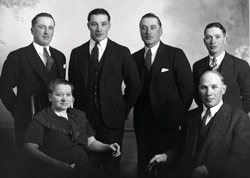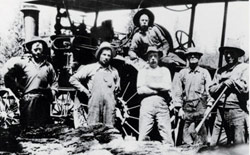Photos Courtesy Frolek Family Collection
 |
|
Frolek Cattle Company livestock graze near picturesque Stump Lake |
On a chilly day, Ray and Donna Frolek’s exuberantly affectionate dog Jessie greets me at the door, with owners in tow. They quickly supply hot coffee and soon have a fire crackling in the brick fireplace. Their cozy home sits not far from Kamloops near the original quarter section that Ray’s grandparents, George and Theresa Frolek, settled in 1906 in the Thompson-Nicola Valley of British Columbia.
The Frolek ranch is a part of B.C.’s interior grasslands, which occupy only one per cent of the province’s land mass. Many rare plant and animal species call the fragile grassland ecosystem home. In the Thompson-Nicola Valley, where annual rainfall is less than 30 centimetres, bunchgrass and sage are the dominant vegetation, with rough fescue more abundant at higher elevations. The Frolek ranch provides a safe home to a number of rare and endangered species such as the blue-listed sharp-tailed grouse, the North American badger and the burrowing owl (protected since the 1980s and the subject of an ongoing reintroduction program at the ranch). Through conservation-minded grazing and range management, generations of the Frolek family have carefully protected the environment on the ranch.
But what of its future?
 |
|
Historical photo of the Frolek family: Theresa and George Frolek with sons, from left: Frank, Alex, Daniel and Charles. |
When George and Theresa Frolek settled the ranch in the early 1900s, George supplemented their income by spending the winters working the Kootenay coal mines in eastern B.C. while Theresa and the boys — Frank, Alex, Daniel and Charles — kept the home fires burning. It proved a tough slog, but gradually the ranch expanded through the purchase of neighbouring properties.
Under the second and third generations of Froleks, the ranch continued to grow, with the acquisition of more parcels. In the early years, each parcel kept its individual operational headquarters, but as road access improved, in time the entire ranch operation centralized at the main property where Ray and Donna now live. The vast ranch is peppered with ghostly remnants of its individual parts: an old abandoned copper mine shut down following the Second World War; Trapp Lake’s deserted one-room schoolhouse and teacherage and surrounding dwellings; and the original log house built by Ray’s grandfather, George Frolek.
Ray was raised in the small log cabin which still sits, now empty except for the memories, near the present ranch house that his parents, Dan and Hilma, built in the early ’60s. Despite the ranch’s land assets, life was pretty bare bones when Ray was growing up. “My parents worked hard to get ahead,” says Ray. “Some years Mom supported us by selling milk, eggs and butter to the restaurants in Kamloops.”
Ray was in the middle, with an older sister Lucille and younger brother Dennis. “I was 16 when we finally got electricity,” he adds. A smile lights his weathered face when he recalls using the team of horses to build log fences, then recounts how the horses needed only to be led a couple of times before they’d bring the log over on their own. Except for a small hiatus spent piloting a long-distance rig across North America, Ray has spent his life on the ranch, working alongside his brother Dennis. Sister Lucille became a teacher, then an accountant, and has worked as the ranch’s office manager since the 1980s.
 |
|
The Frolek family and members of the Nature Conservancy of Canada (NCC) pause for a photo. From left to right: Darren, Paige, Kaden, Emira, Jack and Lucille Dempsey; Chad Affleck, Jan Garnet (NCC), Dennis and Donna Frolek, Ainsley Dempsey, Trinity Frolek, Amanda Affleck, Ray Frolek, Mallery Affleck, Tom Swain (NCC), Katie Blake (NCC) and (kneeling) Barb Pryce (NCC) |
Ray’s wife, Donna, was a city girl from Kamloops, but often visited friends at the nearby Running Horse Ranch with her parents. “I loved animals, so I always dreamed about marrying a rancher,” she laughs. Little did she know that when she grasped the hand of a burly young cowboy named Ray at the local skating rink, she’d end up doing just that.
Ray knew he’d found something special at the skating rink in Kamloops that day, so in 1967 he married Donna and brought her home. To Donna’s delight they soon moved onto the Running Horse Ranch property where she had spent so many happy hours as a child. Later, they moved into the larger house where they raised their family and still live today. It’s a comfortable, welcoming ranch house, lovingly decorated with family photos and ranch memorabilia.
Now grandparents themselves, Ray and Donna actively participate in ranching the land. But family ranching ain’t what it used to be, as developers knock on doors offering provocative amounts of money, younger generations are pulled toward the city life where the dollars are, and it gets harder and harder to see a ranch’s future.
The family had watched in trepidation as neighbouring Stump Lake Ranch was purchased, partly subdivided and developed. In 2005, the Froleks stepped in and purchased what was left, bringing the total deeded acres to 35,000 with approximately another 275,000 in leased or licensed grazing land. That made the Frolek ranch one of the largest ranches in B.C. A family census revealed that nobody wanted to lose the ranch and the life they had come to love.
The family needed a plan.
 |
|
Assisted by the skidding power of a steam engine, George Frolek (centre, arms crossed) and his neighbours gathered into a cutting crew to help each other get firewood for the winter. Date unknown. |
Ray knew the Nature Conservancy of Canada could be a viable option. When he approached the NCC in the spring of 2007, their reaction was one of “absolute delight,” says Barb Pryce, NCC’s Program Manager for the Okanagan. Here was a vast expanse of B.C. interior grassland where little had changed for over 100 years. “Judging by the excellent quality, vigour and abundance of the grasslands, it was readily apparent that generations of the Frolek family had taken superb care of the land,” adds Pryce, who joined several of them on a range ride to pull heifers as part of her research. “It was an unbelievable experience. It’s one memory that I will always retain.”
The property was surveyed, its ecological system studied, plant and animal species inventoried and the area was screened for any possible negative impacts to its biodiversity. “The more we knew, the more excited we became,” she says. In November 2008, NCC purchased a 2,342-acre parcel and leased it back to the Frolek Cattle Company, and protected another 5,486 acres under covenant, agreements that would ensure the land would be safe from any future subdivision and development. It was a win-win situation. “We wanted to ensure the Frolek family could continue their ranching tradition — keep their working ranch working,” says Pryce.
Today, the ranch employs a crew of some 15 farm and ranch employees, including four full-time cowboys. Employees are given their own house and acreage on the ranch. Like other large ranches, the Frolek Ranch has diversified with logging and gravel operations. The ranch runs about 5,000 head of cattle under the Quarter Circle 7 brand, primarily Hereford and Hereford-Angus cross, and about 30 horses. “We never sell our horses, we just retire them to pasture and let them run free,” says Ray, whose sentiment for his horses is clearly reflected in his desire to leave the land as nature intended.
Another generation of Froleks now runs the bulk of the ranch operation, including Ray’s daughter Trinity and her husband Chad, Dennis’s daughter Lark, husband Ken, and Lucille’s son Darren. But once a cowboy, always a cowboy — Ray often takes to the saddle when duty calls and Donna doesn’t hesitate to saddle up and ride alongside him. She still bottle-feeds the orphaned calves that land on her doorstep every spring and can easily recall when she and the kids were Ray’s original ranch hands. A fiercely private man, Ray is regarded with a great deal of respect in the tight-knit local ranching community.
As I pulled myself away from the toasty hearth and headed for the door, I thanked the Froleks for their genial hospitality and complied with Jessie’s demand for farewell affection. On the drive out, I stopped to watch the cattle grazing alongside Stump Lake. Grabbing a handful of sage that was being buffeted by the dry wind, I drew in its unmistakable aroma, thankful, as future generations of ranchers and urban dwellers alike will be, for the Froleks’ stewardship of the land and the guardianship of the NCC.
Ann Chandler is a freelance writer and anthropologist. Her teen novel, Siena Summer, about a famous Italian horse race, was published in September 2008.












